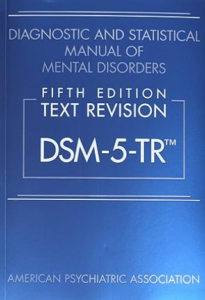home: topics: book: theories: concepts: tf: ab: crit:
10 11 12 13 20 21 22 23 24 25 30 31 32 33 34
40 41 42 43 44 45 46 47 48 50 51 52 (idx)
Understanding DSM-5: Mental Health
The DSM-5 is a book about mental health and brain problems. It’s made by the American Psychiatric Association (APA). They help people who have these kinds of issues. The book’s full name is “The Diagnostic and Statistical Manual of Mental Disorders,” but people call it the DSM. It has almost 1,000 pages. The first version was published in 1952. Major updates happened in 1968, 1980, 1987, 1994, 2000, and most recently in 2019
Find the DSM-5-TR on Amazon (purchase required) us access the DSM-5 Library (subscription required).
The DSM-5 organizes mental disorders into about twenty chapters with a total of 300 mental illnesses. Each chapter covers several disorders that are similar. For example, in the anxiety disorder chapter, there are twelve categories of anxiety and phobias. In the obsessive-compulsive disorder (OCD) chapter, there are five categories.
More Than Just A Book
The DSM-5 is not just a book but a powerful tool in the hands of healthcare professionals. It is a cornerstone in the diagnosis of mental health problems, used by a wide range of professionals, including psychiatrists, clinical psychologists, social workers, licensed professional counselors, medical doctors, and nurses. Its importance in the field cannot be overstated, as it helps identify and understand a myriad of mental health and brain-related conditions, making it an essential resource for mental health professionals.
Even though the DSM is important, there are some criticisms. The first one is that “labeling people” can sometimes be harmful. Also, the DSM emphasizes symptoms and things that can be observed rather than things like one’s social environment. Third, some experts think that descriptions of some disorders have the “bar set too low” and other descriptions are too complex.
Key Takeaway
The DSM-5 is a book about mental health disorders published by the American Psychological Association (APA). It is a valuable diagnostic tool for healthcare professionals in identifying and understanding various mental health conditions.
Questions
Can you explain some ways that the DSM-5 might not be the best way to diagnose mental health problems?
How has the DSM-5 helped psychology researchers find new treatments for mental health issues?
What are some things people should be careful about when using the DSM-5 to diagnose mental health problems?
Access to a DSM-5 PDF format file was viewed from Poltekkes-Kaltim May 1, 2024. The link is provided here with caution and for educational purposes only. Correspondence concerning the repository should be sent to their Administrator or other contacts listed. Find additional information at EdShare Southampton. Users are cautioned, but may have direct access to the archived file. HoneycuttScience is not responsible for security or authenticity of external links. Files and related information here are not intended for clinical use, but provided for educational uses and illustration only. See Terms of Use and Fair Use.
home: topics: book: theories: concepts: tf: ab: crit:
10 11 12 13 20 21 22 23 24 25 30 31 32 33 34
40 41 42 43 44 45 46 47 48 50 51 52 (idx)

